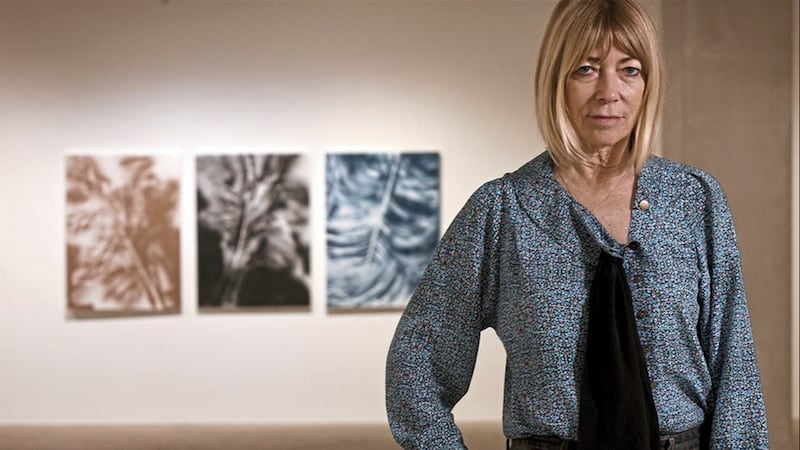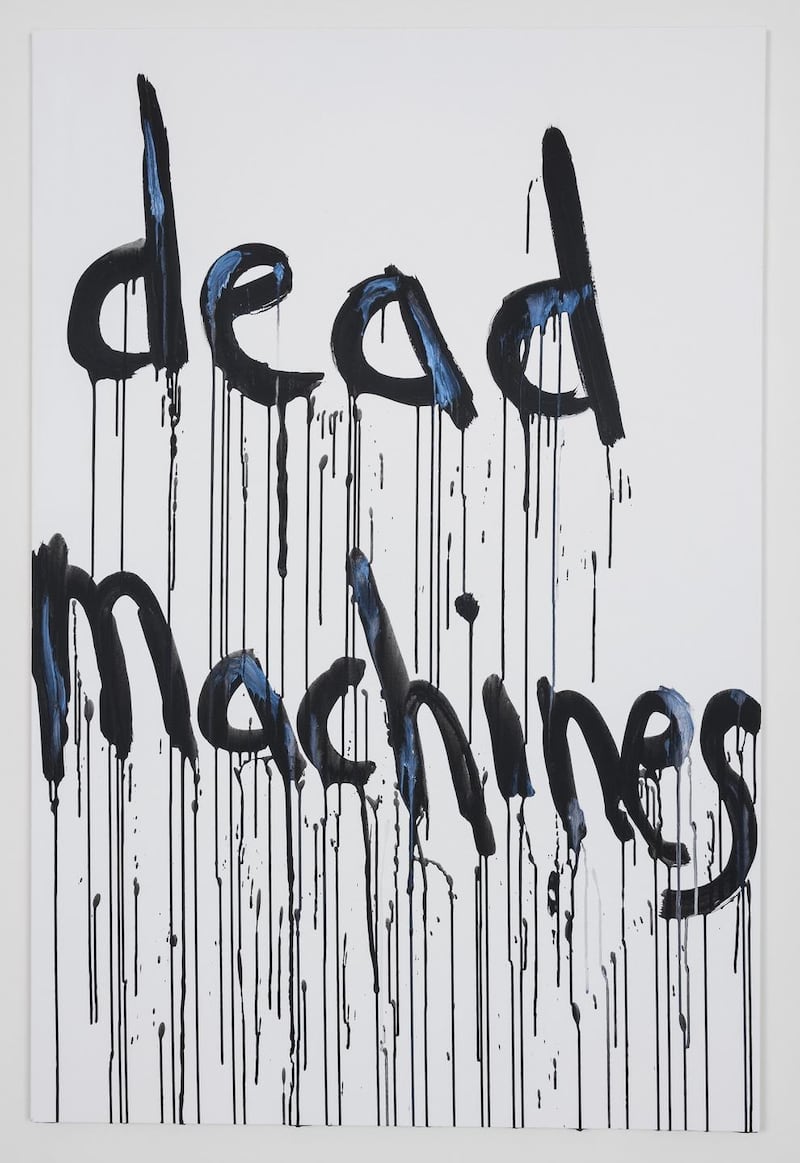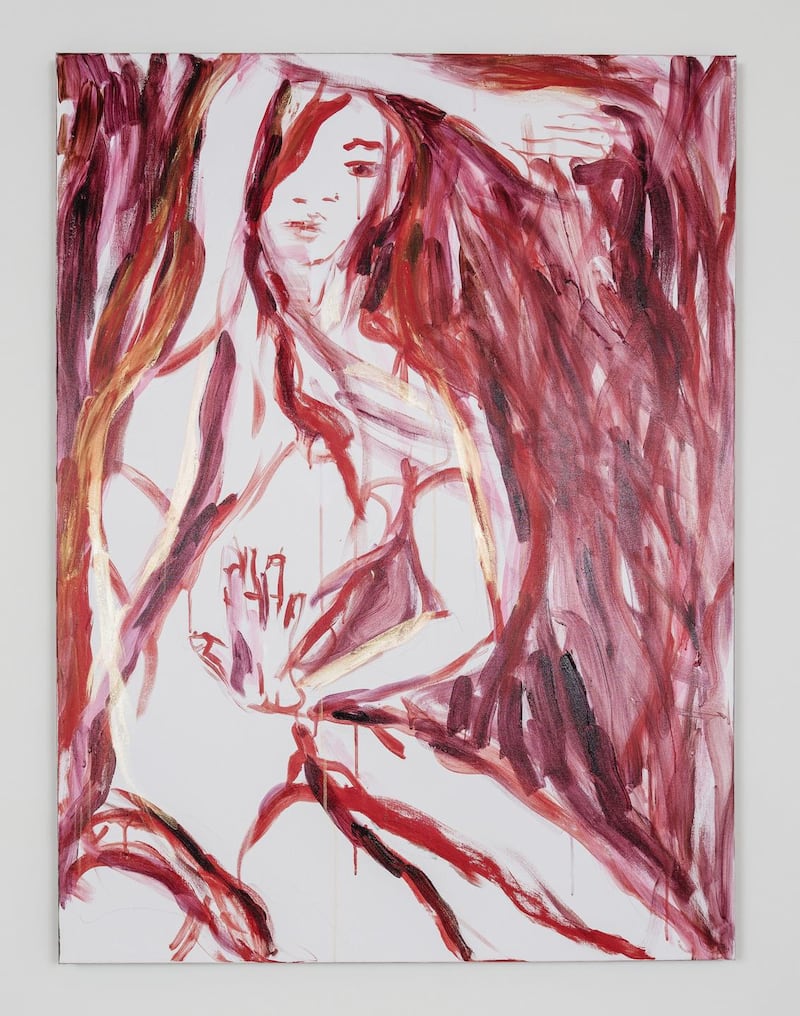Kim Gordon is jet-lagged. She arrives to the galleries in the courtyard of the Irish Museum of Modern Art, a slight figure, clutching a takeaway coffee.
“I’m a bad sleeper,” she says.
We chat for a bit about the difference between the dry warmth of her hometown of LA and the more humid summer we’re having in Dublin. Around us are paintings by Gordon. A pair of tights, made rigid with wood and glue, highlighted with hints of glitter, leans up against a wall.
She is smaller than I had imagined, though isn't that always the way when you meet your heroes? I am trying to keep the hero worship to a minimum, because not only would it be embarrassing for everyone, it is also reserved for the Kim Gordon who was co-founder of 1980s No Wave noise band Sonic Youth. Their dissonant guitars once soundtracked many of my meaningful experiences. But we're here to talk about her work as an artist, from which the band's fame, for a while, took her away.
“Shoot, I don’t know, it’s weird,” she says, when I ask her how she feels about being famous. “I guess I’m sort of used to it. There’s when someone comes up, and says ‘I love your work’ and it’s just, like, awkward to me.”
In fact, Gordon seems pretty uncomfortable all round. Talking about art, even – or especially – your own work, can be a tricky thing, and it’s tough enough to open up to a stranger when you’ve had very little sleep. But in this instance it feels more like a deeply seated guardedness that comes from being at odds, or unsettled, with your place in the world.
“I never think of myself as famous anyway, like, if anything, it’s barely famous,” she adds.
At IMMA, the works on the walls are drawings in paint, ink and glitter. Some are simply words: “#Mood”, “bites”, “Dead Machines”; others are semi-erotic line paintings of women, made with broad, wild gestures, bringing to mind some of Tracey Emin’s drawings, but here with more fluidity and controlled chaos. Gordon notes the spaces at IMMA, how they still have the fireplaces, the plaster mouldings, a sense of the domestic. She has been thinking about Airbnb.
“I’m kind of fascinated, I look a lot. It’s not like I stay in a lot of Airbnbs [but] I like to look online at the pictures, of the way they design everything, how the art becomes just one more thing, like it’s all a modern landscape.”
Curated
For someone who has travelled so much, on tour with the band, Gordon is no stranger to sleeping in spaces where your experience has been curated by someone else. There’s the ersatz luxury of hotels, and the often-alienating, fake domesticity of Airbnb. And then there’s the way art falls into the service of all that branding.
Through our conversation, I come to understand that the show at IMMA is like stepping into Kim Gordon’s Airbnb, albeit without beds or a kitchen. It is like stepping inside what she is prepared to share of her mind. So what do you find? There’s female force in abundance. Despite being slight, Gordon exudes a certain power. She has strong bone structure, huge blue eyes, and her entire face comes alight with unique beauty when she smiles.

You can take a big, abstract painting by a well-known painter, and see it in the lobby of a luxury condo in Chelsea
She speaks mainly in short sentences, with that goofily self-conscious thing that may be a defence mechanism against sounding too clever. Perhaps it's to do with what she describes in her book as the different languages of the art and music worlds, something the artist Raymond Pettitbon had said to her: that it's "not that musicians are unintelligent […] they just don't intellectualise in the same way artists do." Still, I find I want her to go deeper, but her persona seems designed to hold such delvings at a distance.
“It’s interesting,” she says. “You can take a big, abstract painting by a well-known painter, and see it in the lobby of a luxury condo building in Chelsea or something, and it somehow becomes decoration. Design and interior decorating have become so sophisticated, and I’m always kind of interested in that relationship between art and design, kind of symbiotic.”
Gordon has toyed with this idea before. Design Office: Coming Soon (2014), saw the artist install work in the iconic Rudolph Schindler-designed Fitzpatrick-Leland House in the Hollywood Hills. Gordon’s large monochrome wreath paintings hung throughout the house. In the bedroom a pair of her leggings lay, discarded. The whole leggings-on-the-floor thing seems a bit gimmicky to me: that artworld cliche of “presence of absence” vs “absence of presence”, but the richer ideas of staging a space, and of feeling alienated by the staged spaces in which we find ourselves, have, to pardon the pun, legs.
‘Scaffold’
Gordon's memoir, Girl in a Band (2015) details her life: growing up; becoming an artist; her meeting with future husband Thurston Moore; their creation of Sonic Youth; and the couple's subsequent split. In the book, there's a line in which Gordon's friend, the artist and writer Dan Graham, describes how the singer Dean Martin's persona is "both a 'myth' and a 'scaffold'". "It made me realise anyone and anything could be made interesting," writes Gordon.

Looking at Gordon's own "scaffold", her art world life is inextricably intertwined with the New York scene in the 1980s. She arrived fresh from LA's Otis College of Art and Design, along with fellow artist Mike Kelley. Intriguing asides included framing "really schlocky prints" for Larry Gagosian, who hadn't yet worked out how to make millions as an art dealer. She met Andy Warhol, and got him to sign her canvas boots. "No one really knew what was going on," she says. "Occasionally there would be someone coming in from Europe to do an interview about the relationship between art and the Downtown scene," she smiles wryly at the memory, of being part of someone else's idea of an alternative life.
As we talk, music from the video installation Proposal for a Dance (2012) is soundtracking our conversation. In it, Gordon and her niece thrash around, making noise on guitars in a tightly packed Berlin club space. In it, she’s the tall goddess of my memories, and it’s the strongest piece in the show – although Gordon hates the term “performance art”. “I feel like it minimises the potential of what it can be, and how initially groundbreaking it was,” she explains. The idea of Proposal . . . was to “try to make sound without trying to play the guitar, and trying to move without dancing,” which to me sounds like a good description of abstract art: the kind where the artist puts the elements together to create a space to fall into.
All the feminist critique that went on in the '70s and '80s, I guess, the subtleties are really gone. They got wiped away
She tells me she has a solo record coming out that she’s not allowed to talk about yet, but instead gets out her phone and shows me some images from a photoshoot for it at an Airbnb. “It’s really funny,” she says. “They have a lot of these, like, framed words and signs.” She points out pieces on the walls. One announces that “The Adventure Begins Here”; there’s another, in which “Explore” is written over an image of a map of the world. Gordon’s own texts, executed in drippy paint, in part, riff off this idea of word as image, and of declamatory art. Some, such as “Dead Machines”, are the names of noise bands. Others come from the ancient Greek poet Sappho, which Gordon discovered recently through her daughter, Coco. “I was struck by how, on one hand, modern the poetry was. And I like the idea of bringing antiquity into the modern. Then there’s the other idea of the way feminism has been branded.
‘Feminist critique’
“It’s weird right now,” she continues. “With feminism, you have to live a really long time to really see all the manifestations of it [she’s 66]. Every five years there seems to be a new version of it, but at the end it is about equal rights, equal pay. Everything has become very black-and white, especially with the #MeToo movement. All the feminist critique that went on in the ’70s and ’80s, I guess, the subtleties are really gone. They got wiped away.”
As the music-you-can-fall-into plays on in the background, I wonder, if she could do only one, which would she pick: art or music?
“Probably just art,” she says after a long pause to think. “But I would always have music or sound as some aspect to it. I think I keep doing stuff so I don’t become iconicised. Is that a word? I don’t want to feel frozen in one spot.”
Speaking of which, there’s one work still to arrive to complete the installation. Black Glitter Circle (2008) is exactly what it sounds like: a dark, but glittering outline, or the afterimage of a spotlight. I already feel like I’m in the presence of both.
Kim Gordon: She Bites Her Tender Mind is at the Irish Museum of Modern Art until November 10 imma.ie

Art of noise: Sonic Youth’s iconic record sleeves
Kim Gordon says she borrowed the idea for the cover art on the first Sonic Youth EP (1981) from artist Jeff Wall, based on Wall's famous double portrait. The cover of the band's first full studio album, Confusion is Sex (1983) is a white-on-black drawing by Gordon. After that, collaborations and contributions from artist friends became the norm.
Evol (1986) shows a still from Richard Kern’s erotic short film Submit to Me. Kern also directed the video for Sonic Youth’s Death Valley ’69.
Daydream Nation (1988) featured Gerhard Richter’s 1983 painting Kerze (Candle) on its cover.
Goo (1990) was by Raymond Pettibon, who had also designed album covers for American punk band Black Flag, fronted by his brother Greg Ginn.
Dirty (1992) featured sleeve art by Gordon’s longtime friend Mike Kelley, whose images of stuffed animals explore the darker sides of childhood and loss of innocence.
Nurse (2004) showed work by Richard Prince, from his Nurse series, based on pulp fiction covers.












